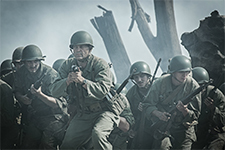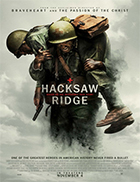Hacksaw Ridge
|  Hacksaw Ridge is Mel Gibson’s first film as director since Apocalypto (2006) a decade ago, and despite all the very nasty water that has gone under the bridge in those 10 years, very little has changed for Gibson as an artist outside of his decision to make a film in English again (his last one being the Oscar-anointed Braveheart 21 years ago). Like Apocalypto and Braveheart (and, to some extent, 2004’s The Passion of the Christ), Hacksaw Ridge is an intriguing mix of the conventional and the unconventional, worked over in broad strokes and thorough interwoven with issues of family and faith and perseverance and self-sacrifice and the will to live. As a filmmaker, Gibson likes to work in big, bold ideas, and his films are, as a result, almost all surface. There isn’t really much of anything when you scratch beneath it, but that’s generally okay because the surface of his films are so compelling in their intense, gritty, hard-edged literalness. Hacksaw Ridge is, at its heart, a very conventional film that is divided into two nearly equal halves. During the first half we meet the film’s protagonist, Desmond T. Doss, and watch him grow from a scrappy boy living a hard-scrabble life in rural Virginia into a devout young man of intense principles and beliefs (Andrew Garfield). He is the product of a complex family dynamic: Tom Doss (Hugo Weaving), is a World War I veteran who lost almost all of his friends in battle and is now a mentally shattered shell of himself given to drink and violence (an interaction with his father, which we see in fragmented flashbacks, helps explain Doss’s later aversion to violence). He meets and falls in love with a pretty young nurse named Dorothy (Teresa Palmer), who is attracted to his sincerity and uniqueness; he isn’t the most socially dynamic of men, but he means what he says. Doss’s beliefs are tested when he volunteers for the Army in World War II, and the second half of the film follows him and his division to the titular ridge on Okinawa, a crucial island in the South Pacific the Americans were trying to take from the Japanese in late 1944. Doss is not your typical war hero in that his Seventh Day Adventist beliefs forbid him from inflicting any kind of violence—from touching a gun, even. That immediately puts him at odds with the commanding officers in the Army, including his drill instructor Sgt. Howell (Vince Vaughn) and Captain Glover (Sam Worthington). (The casting of Vaughn, while bold and appreciated, turns out to be a detriment because he is never truly convincing as a terrifying military figure.) Both Doss’s superiors and several members of his squad think he is either a coward or a lunatic for wanting to go into war without a weapon, and they doubt his usefulness on the battlefield, worrying that he will, in fact, be a liability that will lead to the loss of more lives. Doss just wants to be an Army medic, saving lives in the heat of battle while others take them. As he puts it, “With the world so set on tearing itself apart, don’t seem like such a bad thing to me to want to put a little bit of it back together.” And that is exactly what he is allowed to do, as the 77th Infantry joins the Battle of Okinawa to take out the deeply entrenched Japanese soldiers who hold the island’s high ground, which requires them to scale the 350-foot Maeda Escarpment (the “Hacksaw Ridge” of the title) using cargo nets. The second half of the film details in intense, gruesome detail one of the bloodiest conflicts in World War II, as the American and the Japanese fight viciously for the island, which sets the stage for Doss’s unique heroism as he stays behind at great risk to himself and saves the lives of some 75 wounded men, lowering them one by one in the middle of the night with a system he rigs himself. The initial assault is a surreal, disorienting experience as it unfolds amid billowing smoke and fog that render both sides effectively blind. Gibson draws our attention time and again to the horrors of war—not just the sudden, bloody dismemberment of limbs and the riddling of bodies with bullets, but the always evident aftermath of the various battles, as war is waged on the rat-chewed, maggot-infested remains of those who came before. Yet, this is where Hacksaw Ridge runs into a problem of intention versus execution. The underlying point of the film is to align us with Doss and his unique goal of serving his country at war without actually killing anyone—to be, rather than a conscientious objector, a “conscientious cooperator.” This is precisely what separates Hacksaw Ridge from its war-film brethren, but Gibson and screenwriters Robert Schenkkan and Andrew Knight are unable to sustain that focus. Instead, Gibson is lured by the temptations of war violence rendered cinematic, which shouldn’t be surprising given that every film he has directed since his debut The Man Without a Face (1993) has been defined primarily by the intensity of its bloodshed. That Gibson would want to bring us into the blood and smoke and panic and terror and show us blasted flesh and shattered limbs and wave after wave of flamethrower arcs setting alight both earth and body is understandable, and he does it so well that it’s hard to begrudge his indulgence; he makes us feel the horror of war just as well as the best of his predecessors, including Olive Stone in Platoon (1986) Stanley Kubrick in Full Metal Jacket (1988), and Steven Spielberg in Saving Private Ryan (1998). However, it is hard not to wonder what a more daring and possibly even more affecting film Hacksaw Ridge would have been had Gibson stuck with Doss through the entire ordeal. Instead, he leaves Doss for substantial periods of time, following rather conventional war film narratives about charging the lines, taking out machine gun nests with bombs, and strategizing how to outflank the enemy. In these moments, the film sinks into well-mounted, but familiar mini-narratives that really have nothing to do with Doss and everything to do with the dictates of the war genre. What if Gibson had stayed with Doss as he tended to the wounded while the hell of battle raged incoherently around him? What if the film’s point of view had been solely with the man who refused to touch a rifle except to use it as a makeshift carrier—essentially foregoing the conventions of the genre and immersing us in the experience of truly trying to put back together the world as it is being blown apart all around you? Copyright © 2016 James Kendrick Thoughts? E-mail James Kendrick All images copyright © Summit Entertainment |
Overall Rating: 

 (3)
(3)


